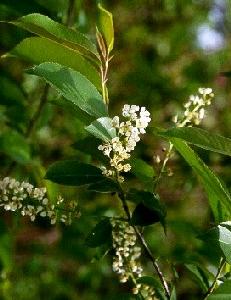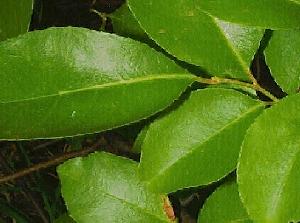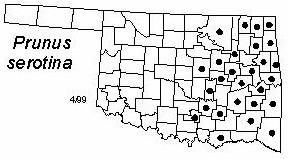
 Tree to 32 m (100 ft) in height. Bark red-brown, furrowed. Twigs red-brown to gray, smooth when young, lenticels gray to black. Leaves alternate, simple; oval to oblong-lanceolate, 5-15 cm (2-6 in) long and 2.5-5 cm (1-2 in) wide; glabrous, but hairs may be present on the midrib beneath; dark green; cuneate at base; acuminate at apex; margins serrate. Inflorescence a raceme of several flowers; calyx tube of short lobes; petals 5, white; stigmas flattened; stamens numerous; flowers appear from March to June. Fruit a drupe, about 12 mm (1/2 in) in diameter, obovoid; seed a single stone about 8 mm (1/3 in) in diameter, black; fruits mature in June to October.
Tree to 32 m (100 ft) in height. Bark red-brown, furrowed. Twigs red-brown to gray, smooth when young, lenticels gray to black. Leaves alternate, simple; oval to oblong-lanceolate, 5-15 cm (2-6 in) long and 2.5-5 cm (1-2 in) wide; glabrous, but hairs may be present on the midrib beneath; dark green; cuneate at base; acuminate at apex; margins serrate. Inflorescence a raceme of several flowers; calyx tube of short lobes; petals 5, white; stigmas flattened; stamens numerous; flowers appear from March to June. Fruit a drupe, about 12 mm (1/2 in) in diameter, obovoid; seed a single stone about 8 mm (1/3 in) in diameter, black; fruits mature in June to October.
Distribution: Oklahoma, Texas and Arkansas, east to Florida, north to Nova Scotia, west to North Dakota. Common in eastern Okahoma.
Habitat: valleys and floodplains.
Comment: Prunus is the latin name for plum; serotina means "late-flowering".
Food use: bark extract is used as a flavoring. The fruits are occasionallly made into wine.
Horticulture: the rich colors of the bark make black cherry an attractive ornamental tree. First cultivated in 1629.
Ecomonic value: wood is used for making fine furniture, cabinets, veneers, and tools.
Wildlife benefits: the fruits are eaten by a wide variety of birds and mammals.
NWI status: FACU
Distribution in Oklahoma: 
BACK
NEXT
RETURN TO INDEX
Last update: 9/15/99
 Go to Oklahoma Biological Survey Home Page
Go to Oklahoma Biological Survey Home Page
 Disclaimer
Disclaimer